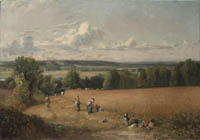Constable and After
Sir Edwin Manton and the British Landscape
December 23, 2009–January 24, 2011

John Constable
The Wheatfield
1816. Gift of the Manton Foundation in memory of Sir Edwin and Lady Manton. The Clark, Williamstown, MA
John Constable’s use of sketchy brushstrokes of color and his focus on rural landscape were considered radical in an age when paintings were expected to have a high degree of finish, and historical or religious subjects were in favor. Official recognition came only later in his career, but Constable’s innovative approach to landscape painting—working in the open air to capture the changing effects of light and the movement of clouds—earned him many admirers and followers, both amateur and professional. Painters such as Alfred Vickers, Thomas Churchyard, James Gubbins Archer-Burton, and Lionel Constable, son of the artist, imitated his style so closely that their works are often confused with those of the elder Constable. Later, Constable was heralded as a precursor to the Impressionists, who were said to have adopted his practice of open-air painting to create their own innovative style.
Many of the paintings and drawings on display in this gallery were assembled by business leader and arts patron Sir Edwin A. G. Manton (1909–2005) and his wife Florence, Lady Manton. The collection, a recent gift of the Manton Foundation, includes works of art by Constable, J. M. W. Turner, and Thomas Gainsborough, among other leading British artists of the eighteenth and nineteenth centuries. With its concentration on landscape, the Manton Collection reflects Sir Edwin’s love of his native England; he was born in Essex County, not far from Constable’s birthplace.